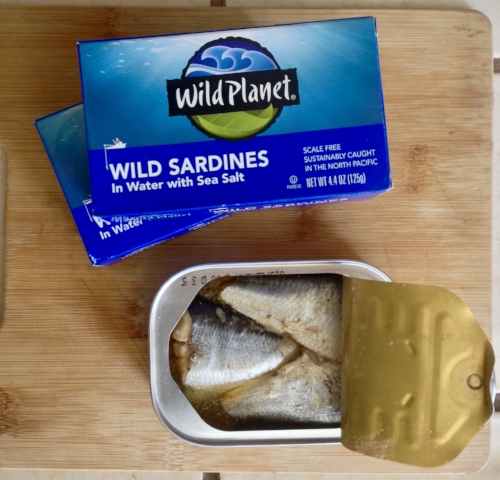Of All the Fish in the Sea
Why You Should Try Sardines
As a Nutritionist, I am constantly seeking foods that act as “whole food multi-vitamins”, aka superfoods. Sardines are it. Before you dismiss these little fish(seas), hear me out. Sardines are a nutritional powerhouse and check all the boxes of a sustainability minded, environmentally conscious, public health concerned, pescatarian consumer. They are politically correct enough to star in a Portlandia episode and cheap enough to be a fish-scale-ly responsible pantry staple.
Tuna fish sandwiches were a standard in the Knipp household growing up, claiming at least two or three lunches per week. It wasn’t until my early twenties that I finally cut back on the canned tuna to lower my toxic metal exposure. But I missed it so… hoping that one-day research would reveal mercury isn’t really that bad for you…
Finally, a solution came for my nostalgic canned fish needs! During one of my first classes at Bauman I was introduced to the idea of eating Sardines. I had never tried them, but left immediately after class to buy a can, prepared them as I would tuna fish salad (organic mayo, pickle juice, celery, S &P), and ate the entire bowl in pure ecstasy. Now, sardine salad is a regular part of my diet and I recommend eating sardines a few times a month to almost all of my clients. And here are some of the immediate responses I get in return:
Politely nod in agreement, while inside they are thinking “oh, hell no!”
Q: Even the bones, and skin and such? A: Yes, the bones are so small that once you mix them up in a salad you won’t even notice. The skin and bones are full of beautifying vitamins and nutrients for healthy hair, skin, and nails.
Q: Aren’t they super salty? A: No, you may be thinking of anchovies, which are persevered in salt. You can buy un-salted, canned Sardines.
Q: Do they taste like fish? A: Yes, they are fish so they may taste like fish. There are countless ways to dress them up and make them delicious.
Or the rare, “Cool! I’m trying some tomorrow!”
If you are a part of the hesitant majority, I dare you to at least give them a try. Don’t be such a guppy! This article will help answer all your sardine questions. The health benefits are staggering and may hopefully change your mind.
The Health Benefits of Sardines:
The nutrient density of sardines is so high it gives the phrase “packed in like Sardines” new meaning… because high amounts of omega 3, protein, minerals (calcium, selenium, phosphorus), vitamin D, and B-vitamins are packed in…like sardines…in sardines. The Daily Recommended Value (DV) of nutrients like calcium, selenium, and vitamin D are harder to acquire through diet alone, which gives people who eat sardines a natural boost. I highly recommend eating sardines for anyone suffering from an inflammatory condition, a recent bone injury, or hormone imbalance.
3.75 oz. (1 Can) of Sardines in water contain about:
Phosphorus: 440 mg, 60% DV
B12: 8 mcg, over 300% DV
Vitamin D: 175 IU, 44% DV
Calcium: 340 mg, 30% DV
Calories: 130
Protein: 17 g
Omega 3: 1.3 g
Selenium: 47 mcg, 87% DV
The nutrients found in Sardines make them excellent for:
- Bone Health
- Nail, Hair, and Skin Support
- Reducing Inflammation
- Balancing Mood Disorders
- Regulating Blood Sugar
- Promoting Weight Loss
A less toxic, more sustainable option:
Sardines are low on the food chain, feed on algae and plankton, and have a high reproduction rate. This makes them a less toxic, more sustainable option over other seafood. Due to their short lifespan, they contain significantly lower amounts of toxins like Mercury and PCB's than those found in larger fish like Tuna and Swordfish. With a changing climate, pollution, and over-fishing issues, it is important to consider the ecological implications of eating seafood. Monterey Bay Aquarium's The Seafood Watch offers an updated Consumer Guide based on region. I urge you to take a look!
How to Buy: Fresh vs. Canned?
Fresh seafood is almost always preferable to buying canned. As with all fish, clean and remove scales before cooking. Cook within one to two days to ensure freshness. Can be grilled, fried, baked, or steamed to your liking. Fresh sardines are available at most fish counters and markets. If you don’t see them, ask! Your grocer/ seafood supplier is there for YOU! If nothing else, maybe you’ll make a new friend…
If buying from a can:
- Look for BPA-free cans. This applies to all canned food: beans, soups, tomatoes, etc. BPA is a chemical ingredient in plastics used to line metal cans. It is a known endocrine disruptor that negatively impacts hormone regulation.
- Choose fish stored in olive oil or water because they are less likely to contain damaged oils that are high in inflammatory Omega-6 fatty acids.
- Buy wild caught fish rather than farmed fish. From a nutrition standpoint, wild caught is better than farmed raised. Farmed fish are fed antibiotics and pesticides to rid disease and cheap, readily available corn and soy, which lowers the Omega 3/Omega 6 ratio and protein content by up to 20%.
- Look for Wild Caught North Pacific over Atlantic or Mediterranean Sardines due to over fishing in Atlantic regions.
Recipes: Sardines Two Ways
Canned sardines are convenient for on-the-go cooking. They are virtually prep free and can be brightened up with fresh ingredients like crisp green apple, celery, and lemon juice. I like making this Sardine Chickpea Salad for lunch or as a snack. Will keep in fridge for up to 3-4 days.
Sardine Chickpea Salad
About 2 servings
Ingredients:
- 1 can (3.75 oz) Wild Pacific Sardines , drained
- 1 cup Chickpeas (soaked and cooked or canned and drained)
- 2 stalks celery, sliced diagonally
- ½ medium red onion, chopped
- ½ green apple, cored and chopped*
- ¼ cup parsley, roughly chopped
- 1 tbsp lemon juice (1/2 lemon), 1 tsp zest reserved
- 1- 2 tbsp extra virgin olive oil
- ¼ tsp sea salt
- fresh ground pepper
Instructions:
1. Combine sardines, chickpeas, celery, red onion, apple, and parsley.
2. Whisk lemon juice, zest, olive oil, salt and pepper together in small bowl. Pour over sardine salad until evenly dressed.
3. Serve over 2 cups peppery arugula with fennel, radish and avocado for lunch, or eat as a snack with your favorite gluten free crackers.
*squeeze a little lemon juice on the apple, and save as a snack for later with 2 tbsp nut butter.
Gluten-Free Sardine Fish Sticks
3-4 servings
Do you like Fish Sticks? Do you like putting fish stick in your mouth? I do. And I found a great recipe for Gluten-Free Fish Sticks made from fresh sardines. …The most politically correct of all fish sticks. I purchased 4 sardines for about $2 at the local fish market. If you have never cleaned a fish before, this article from Saveur will show you how.
Ingredients:
- 6-8 sardines, cleaned and filleted
- 1/3 cup corn flour, seasoned
- 1 cup almond meal, seasoned
- 2 eggs, beaten
- 1/4 cup avocado or coconut oil
- 1 lemon, seeded and wedged for garnish
Tartar Sauce
- 1/2 cup mayonnaise
- 2 tbsp minced pickle (relish)
- 1 tbsp minced onion
- 1 tbsp lemon juice (1/2 lemon)
- 1 tsp minced parsley, some reserved for garnish
- salt and pepper to taste
Instructions:
- Make quick tartar sauce by mixing ingredients in small bowl, cover, and store in fridge for an hour before serving.
- Prep the sardines as directed, making sure to pat them dry. Set up your dredging station with three shallow dishes for the corn flour, whisked egg, and almond meal. Using the tail of the fish, coat each fillet in corn flour, then egg, then almond meal.
- Meanwhile, heat your oil in skillet or frying pan. Test by dropping a few crumbs in oil to hear them sizzle. Depending on pan size, carefully place fillets in oil a few at a time for 2-3 minutes until golden brown - flipping once to cook evenly. Place on paper towel to absorb excess oil.
- Transfer to serving plate with tartar sauce, lemon wedges, and sprinkle with parsley. Enjoy!







